Management Accounting Report: Buccaneers Ltd Cost Analysis and Budgets
VerifiedAdded on 2019/12/03
|18
|4077
|127
Report
AI Summary
This report provides a comprehensive analysis of management accounting principles within the context of Buccaneers Ltd. It begins with an introduction to management accounting and its importance in decision-making, followed by a detailed examination of cost information, including direct and indirect costs, and various costing methods such as process costing, which is applied to Buccaneers Ltd's production processes. The report then proposes methods for cost reduction and value enhancement, emphasizing the use of financial and non-financial performance indicators. Furthermore, it delves into the preparation of forecasts and budgets, outlining the budgeting process and its key purposes. Finally, the report addresses performance monitoring, covering financial statements and ratio analysis. The report concludes with a summary of the key findings and recommendations for Buccaneers Ltd.
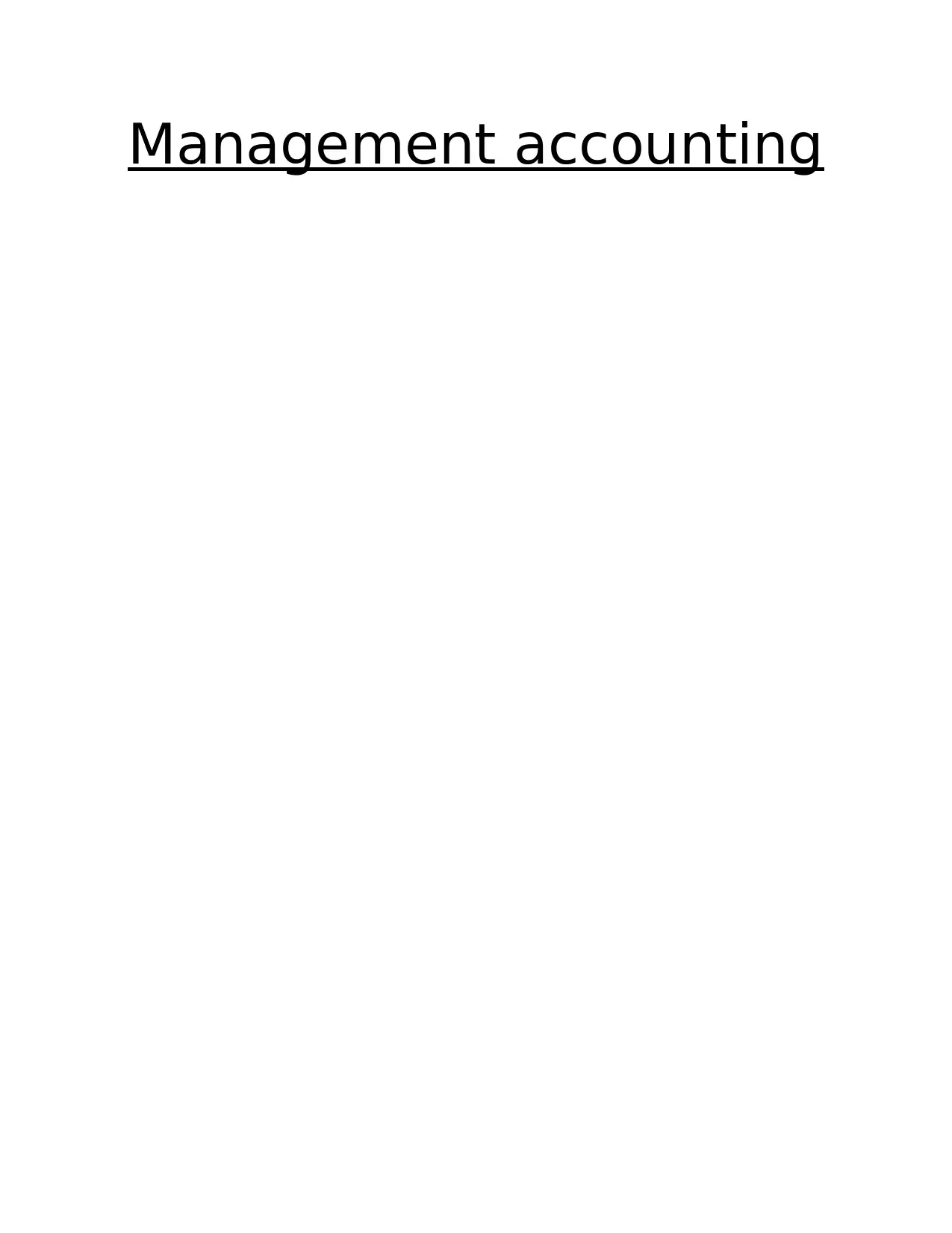
Management accounting
Paraphrase This Document
Need a fresh take? Get an instant paraphrase of this document with our AI Paraphraser
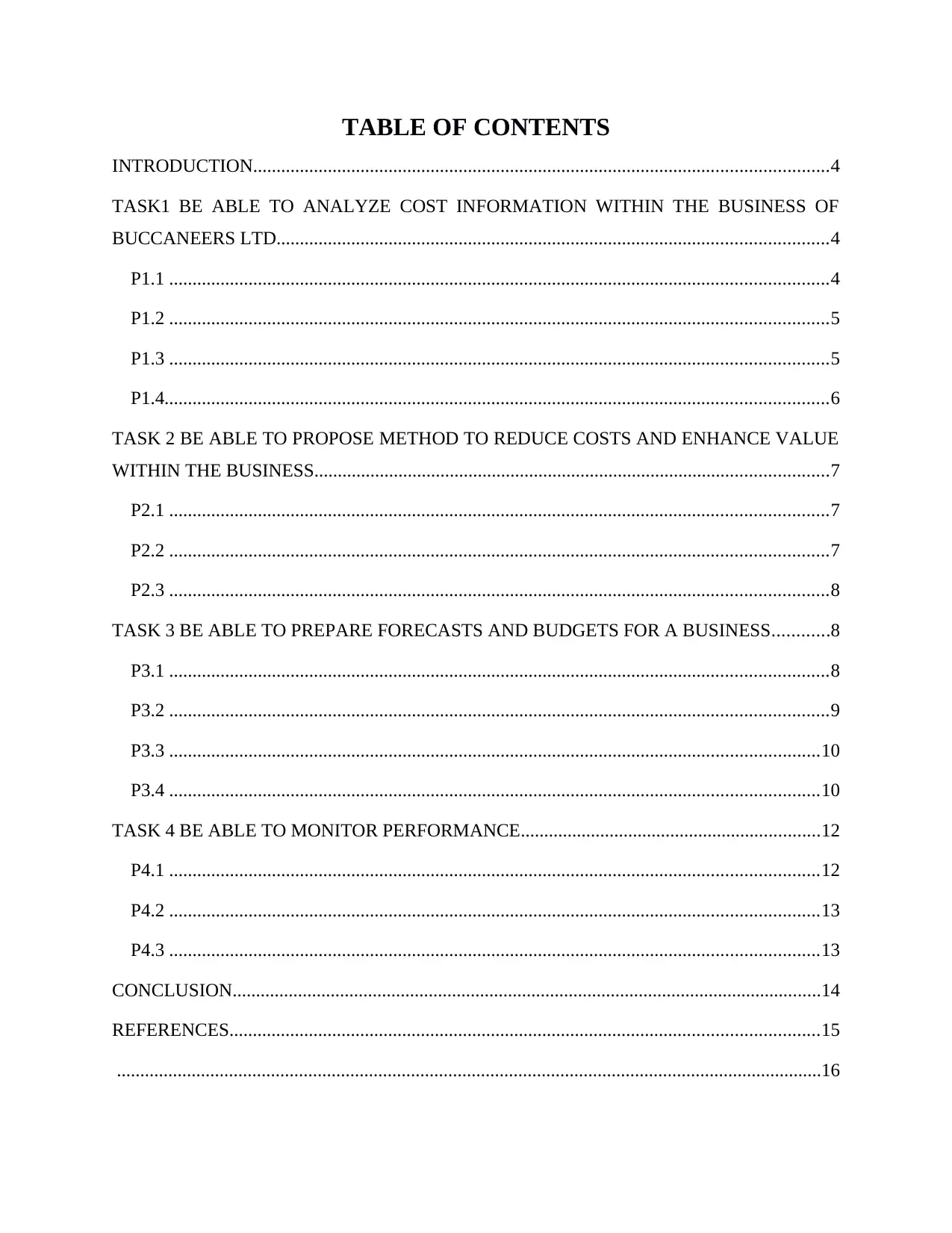
TABLE OF CONTENTS
INTRODUCTION...........................................................................................................................4
TASK1 BE ABLE TO ANALYZE COST INFORMATION WITHIN THE BUSINESS OF
BUCCANEERS LTD......................................................................................................................4
P1.1 .............................................................................................................................................4
P1.2 .............................................................................................................................................5
P1.3 .............................................................................................................................................5
P1.4..............................................................................................................................................6
TASK 2 BE ABLE TO PROPOSE METHOD TO REDUCE COSTS AND ENHANCE VALUE
WITHIN THE BUSINESS..............................................................................................................7
P2.1 .............................................................................................................................................7
P2.2 .............................................................................................................................................7
P2.3 .............................................................................................................................................8
TASK 3 BE ABLE TO PREPARE FORECASTS AND BUDGETS FOR A BUSINESS............8
P3.1 .............................................................................................................................................8
P3.2 .............................................................................................................................................9
P3.3 ...........................................................................................................................................10
P3.4 ...........................................................................................................................................10
TASK 4 BE ABLE TO MONITOR PERFORMANCE................................................................12
P4.1 ...........................................................................................................................................12
P4.2 ...........................................................................................................................................13
P4.3 ...........................................................................................................................................13
CONCLUSION..............................................................................................................................14
REFERENCES..............................................................................................................................15
.......................................................................................................................................................16
INTRODUCTION...........................................................................................................................4
TASK1 BE ABLE TO ANALYZE COST INFORMATION WITHIN THE BUSINESS OF
BUCCANEERS LTD......................................................................................................................4
P1.1 .............................................................................................................................................4
P1.2 .............................................................................................................................................5
P1.3 .............................................................................................................................................5
P1.4..............................................................................................................................................6
TASK 2 BE ABLE TO PROPOSE METHOD TO REDUCE COSTS AND ENHANCE VALUE
WITHIN THE BUSINESS..............................................................................................................7
P2.1 .............................................................................................................................................7
P2.2 .............................................................................................................................................7
P2.3 .............................................................................................................................................8
TASK 3 BE ABLE TO PREPARE FORECASTS AND BUDGETS FOR A BUSINESS............8
P3.1 .............................................................................................................................................8
P3.2 .............................................................................................................................................9
P3.3 ...........................................................................................................................................10
P3.4 ...........................................................................................................................................10
TASK 4 BE ABLE TO MONITOR PERFORMANCE................................................................12
P4.1 ...........................................................................................................................................12
P4.2 ...........................................................................................................................................13
P4.3 ...........................................................................................................................................13
CONCLUSION..............................................................................................................................14
REFERENCES..............................................................................................................................15
.......................................................................................................................................................16

⊘ This is a preview!⊘
Do you want full access?
Subscribe today to unlock all pages.

Trusted by 1+ million students worldwide
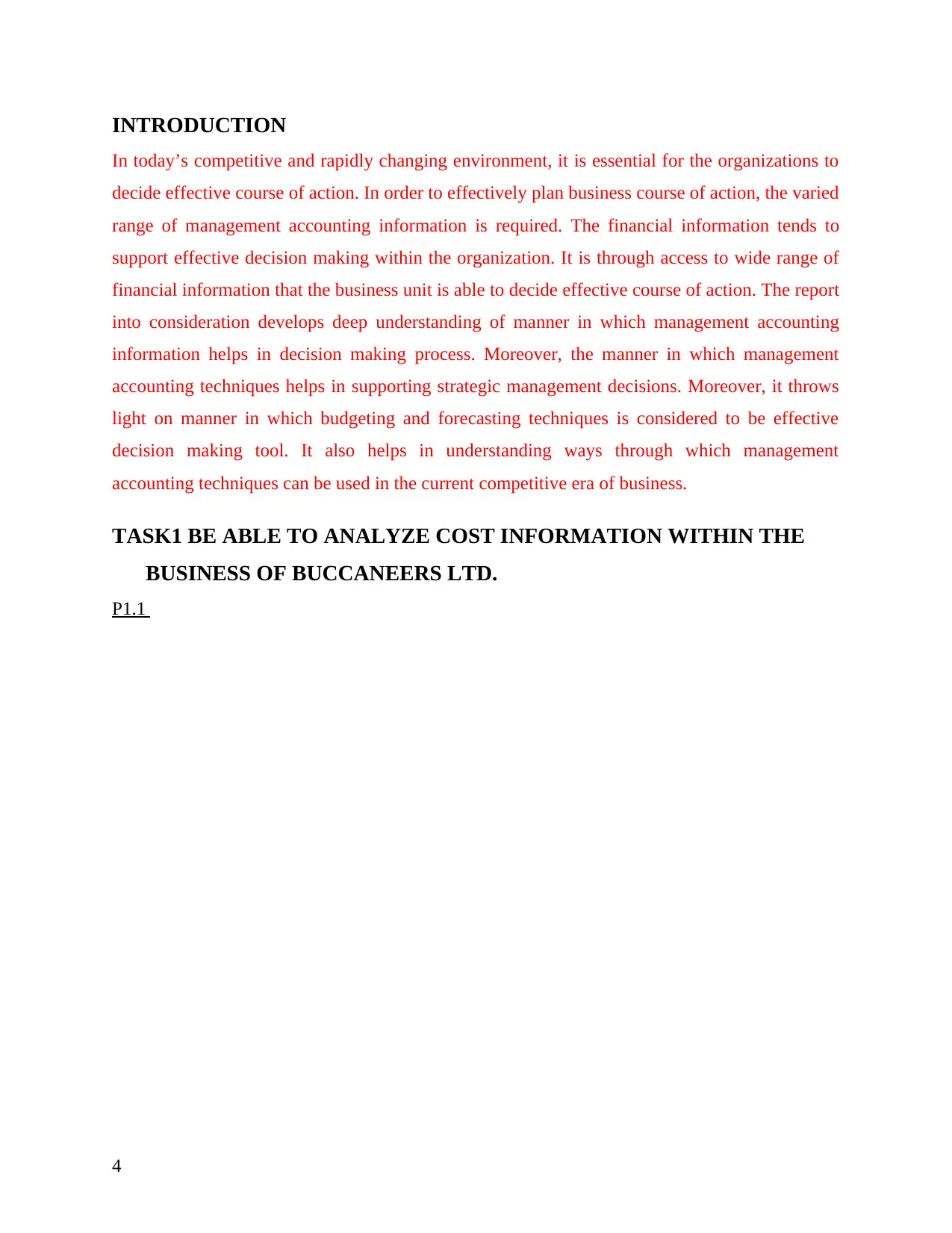
INTRODUCTION
In today’s competitive and rapidly changing environment, it is essential for the organizations to
decide effective course of action. In order to effectively plan business course of action, the varied
range of management accounting information is required. The financial information tends to
support effective decision making within the organization. It is through access to wide range of
financial information that the business unit is able to decide effective course of action. The report
into consideration develops deep understanding of manner in which management accounting
information helps in decision making process. Moreover, the manner in which management
accounting techniques helps in supporting strategic management decisions. Moreover, it throws
light on manner in which budgeting and forecasting techniques is considered to be effective
decision making tool. It also helps in understanding ways through which management
accounting techniques can be used in the current competitive era of business.
TASK1 BE ABLE TO ANALYZE COST INFORMATION WITHIN THE
BUSINESS OF BUCCANEERS LTD.
P1.1
4
In today’s competitive and rapidly changing environment, it is essential for the organizations to
decide effective course of action. In order to effectively plan business course of action, the varied
range of management accounting information is required. The financial information tends to
support effective decision making within the organization. It is through access to wide range of
financial information that the business unit is able to decide effective course of action. The report
into consideration develops deep understanding of manner in which management accounting
information helps in decision making process. Moreover, the manner in which management
accounting techniques helps in supporting strategic management decisions. Moreover, it throws
light on manner in which budgeting and forecasting techniques is considered to be effective
decision making tool. It also helps in understanding ways through which management
accounting techniques can be used in the current competitive era of business.
TASK1 BE ABLE TO ANALYZE COST INFORMATION WITHIN THE
BUSINESS OF BUCCANEERS LTD.
P1.1
4
Paraphrase This Document
Need a fresh take? Get an instant paraphrase of this document with our AI Paraphraser
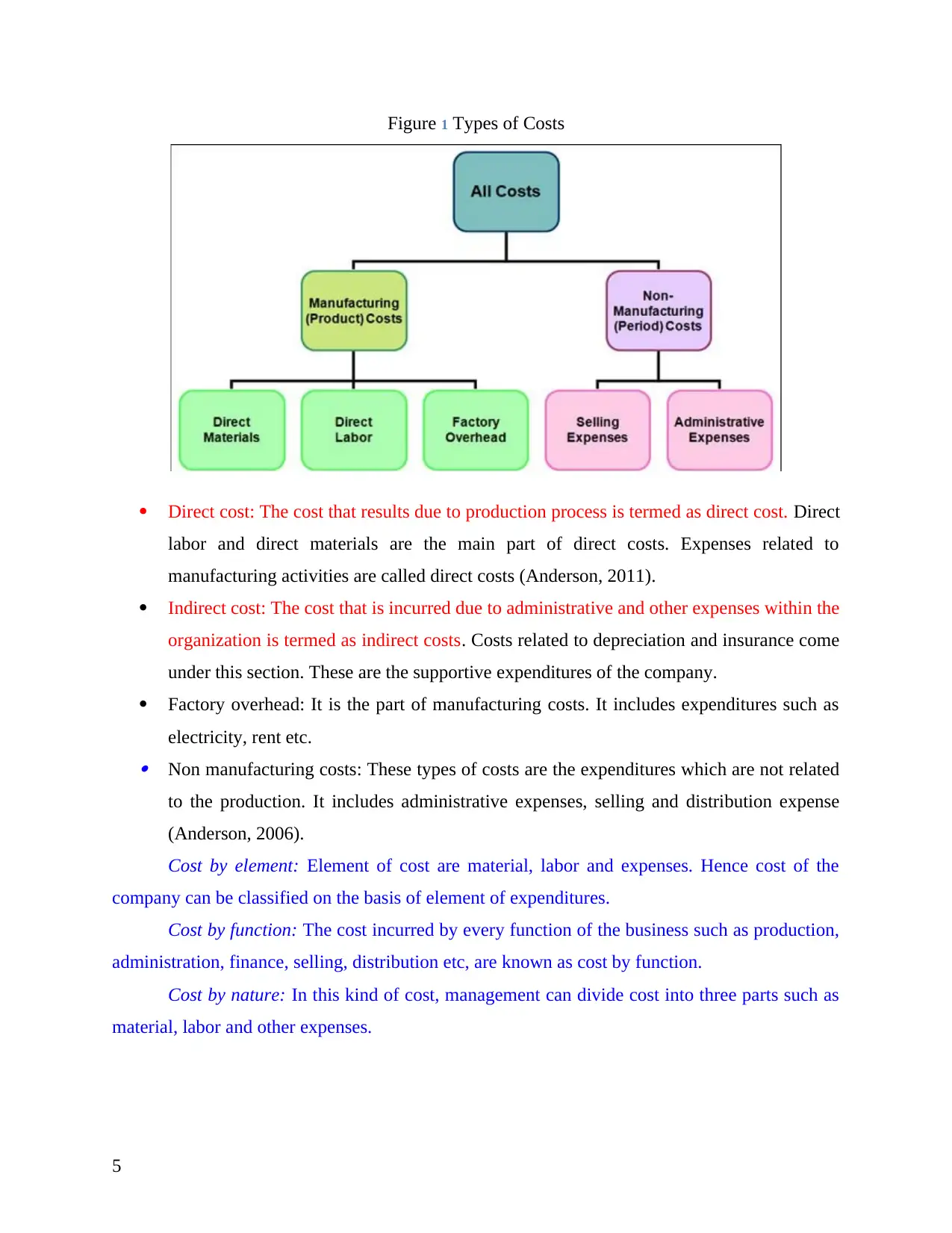
Figure 1 Types of Costs
Direct cost: The cost that results due to production process is termed as direct cost. Direct
labor and direct materials are the main part of direct costs. Expenses related to
manufacturing activities are called direct costs (Anderson, 2011).
Indirect cost: The cost that is incurred due to administrative and other expenses within the
organization is termed as indirect costs. Costs related to depreciation and insurance come
under this section. These are the supportive expenditures of the company.
Factory overhead: It is the part of manufacturing costs. It includes expenditures such as
electricity, rent etc. Non manufacturing costs: These types of costs are the expenditures which are not related
to the production. It includes administrative expenses, selling and distribution expense
(Anderson, 2006).
Cost by element: Element of cost are material, labor and expenses. Hence cost of the
company can be classified on the basis of element of expenditures.
Cost by function: The cost incurred by every function of the business such as production,
administration, finance, selling, distribution etc, are known as cost by function.
Cost by nature: In this kind of cost, management can divide cost into three parts such as
material, labor and other expenses.
5
Direct cost: The cost that results due to production process is termed as direct cost. Direct
labor and direct materials are the main part of direct costs. Expenses related to
manufacturing activities are called direct costs (Anderson, 2011).
Indirect cost: The cost that is incurred due to administrative and other expenses within the
organization is termed as indirect costs. Costs related to depreciation and insurance come
under this section. These are the supportive expenditures of the company.
Factory overhead: It is the part of manufacturing costs. It includes expenditures such as
electricity, rent etc. Non manufacturing costs: These types of costs are the expenditures which are not related
to the production. It includes administrative expenses, selling and distribution expense
(Anderson, 2006).
Cost by element: Element of cost are material, labor and expenses. Hence cost of the
company can be classified on the basis of element of expenditures.
Cost by function: The cost incurred by every function of the business such as production,
administration, finance, selling, distribution etc, are known as cost by function.
Cost by nature: In this kind of cost, management can divide cost into three parts such as
material, labor and other expenses.
5
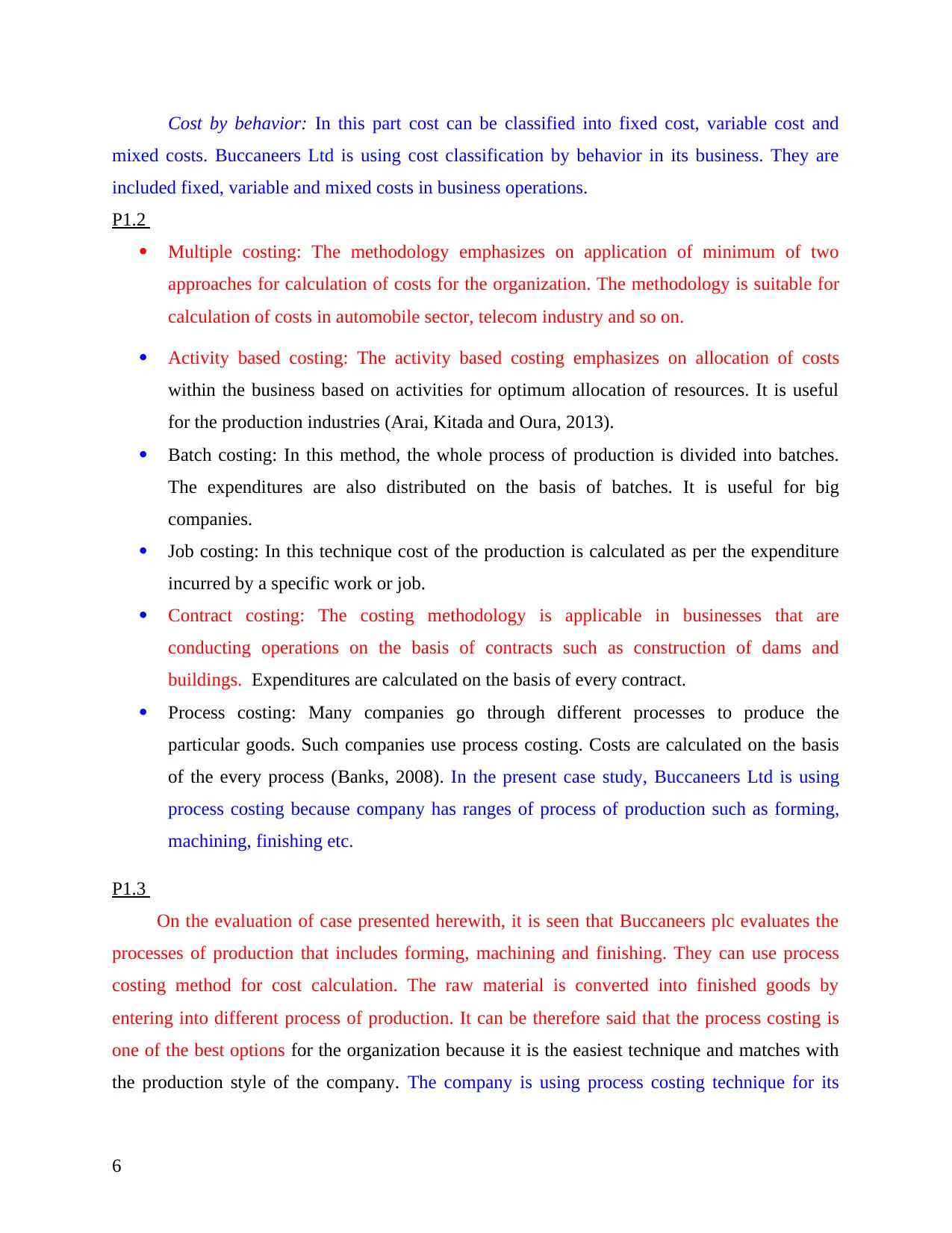
Cost by behavior: In this part cost can be classified into fixed cost, variable cost and
mixed costs. Buccaneers Ltd is using cost classification by behavior in its business. They are
included fixed, variable and mixed costs in business operations.
P1.2
Multiple costing: The methodology emphasizes on application of minimum of two
approaches for calculation of costs for the organization. The methodology is suitable for
calculation of costs in automobile sector, telecom industry and so on.
Activity based costing: The activity based costing emphasizes on allocation of costs
within the business based on activities for optimum allocation of resources. It is useful
for the production industries (Arai, Kitada and Oura, 2013).
Batch costing: In this method, the whole process of production is divided into batches.
The expenditures are also distributed on the basis of batches. It is useful for big
companies.
Job costing: In this technique cost of the production is calculated as per the expenditure
incurred by a specific work or job.
Contract costing: The costing methodology is applicable in businesses that are
conducting operations on the basis of contracts such as construction of dams and
buildings. Expenditures are calculated on the basis of every contract.
Process costing: Many companies go through different processes to produce the
particular goods. Such companies use process costing. Costs are calculated on the basis
of the every process (Banks, 2008). In the present case study, Buccaneers Ltd is using
process costing because company has ranges of process of production such as forming,
machining, finishing etc.
P1.3
On the evaluation of case presented herewith, it is seen that Buccaneers plc evaluates the
processes of production that includes forming, machining and finishing. They can use process
costing method for cost calculation. The raw material is converted into finished goods by
entering into different process of production. It can be therefore said that the process costing is
one of the best options for the organization because it is the easiest technique and matches with
the production style of the company. The company is using process costing technique for its
6
mixed costs. Buccaneers Ltd is using cost classification by behavior in its business. They are
included fixed, variable and mixed costs in business operations.
P1.2
Multiple costing: The methodology emphasizes on application of minimum of two
approaches for calculation of costs for the organization. The methodology is suitable for
calculation of costs in automobile sector, telecom industry and so on.
Activity based costing: The activity based costing emphasizes on allocation of costs
within the business based on activities for optimum allocation of resources. It is useful
for the production industries (Arai, Kitada and Oura, 2013).
Batch costing: In this method, the whole process of production is divided into batches.
The expenditures are also distributed on the basis of batches. It is useful for big
companies.
Job costing: In this technique cost of the production is calculated as per the expenditure
incurred by a specific work or job.
Contract costing: The costing methodology is applicable in businesses that are
conducting operations on the basis of contracts such as construction of dams and
buildings. Expenditures are calculated on the basis of every contract.
Process costing: Many companies go through different processes to produce the
particular goods. Such companies use process costing. Costs are calculated on the basis
of the every process (Banks, 2008). In the present case study, Buccaneers Ltd is using
process costing because company has ranges of process of production such as forming,
machining, finishing etc.
P1.3
On the evaluation of case presented herewith, it is seen that Buccaneers plc evaluates the
processes of production that includes forming, machining and finishing. They can use process
costing method for cost calculation. The raw material is converted into finished goods by
entering into different process of production. It can be therefore said that the process costing is
one of the best options for the organization because it is the easiest technique and matches with
the production style of the company. The company is using process costing technique for its
6
⊘ This is a preview!⊘
Do you want full access?
Subscribe today to unlock all pages.

Trusted by 1+ million students worldwide
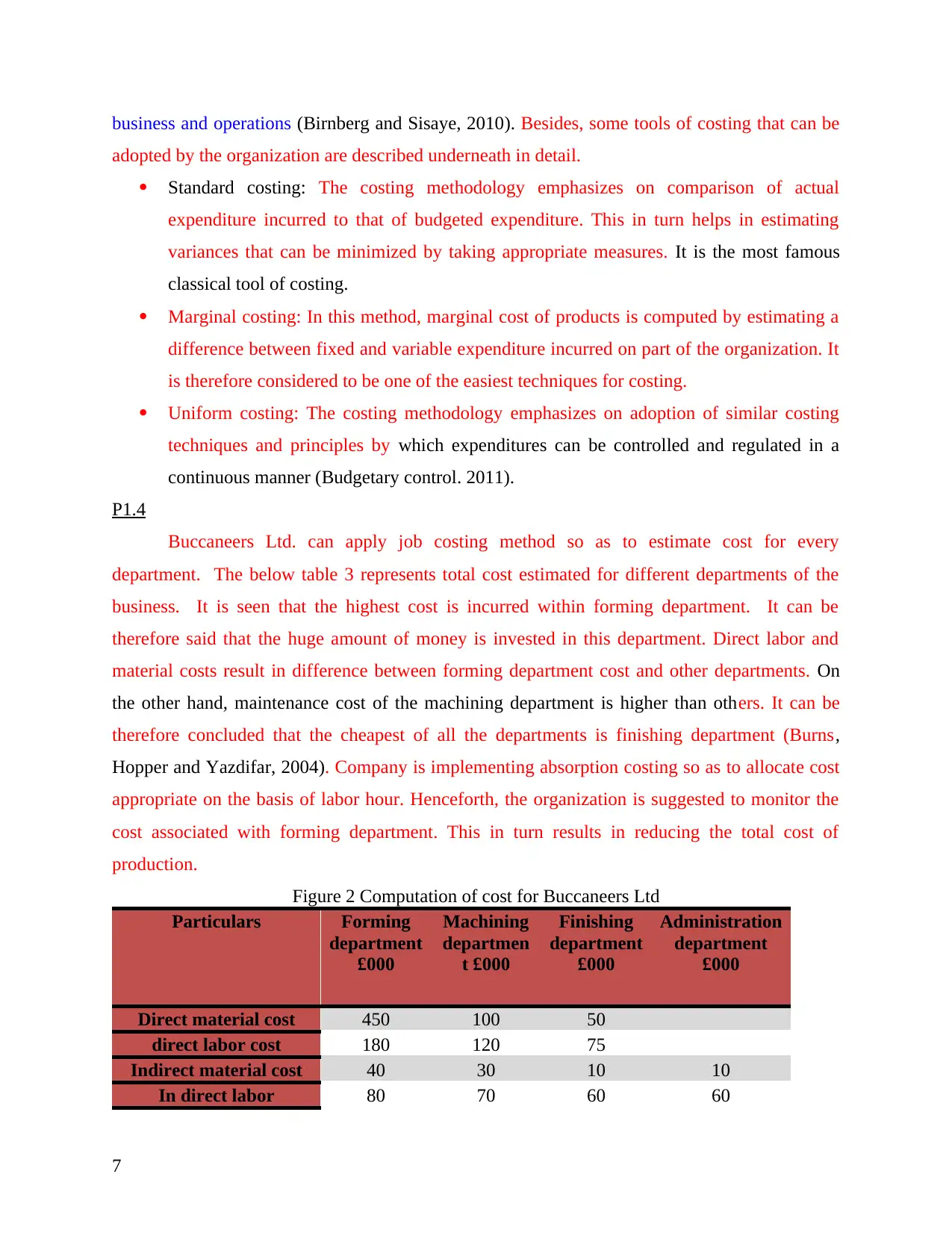
business and operations (Birnberg and Sisaye, 2010). Besides, some tools of costing that can be
adopted by the organization are described underneath in detail.
Standard costing: The costing methodology emphasizes on comparison of actual
expenditure incurred to that of budgeted expenditure. This in turn helps in estimating
variances that can be minimized by taking appropriate measures. It is the most famous
classical tool of costing.
Marginal costing: In this method, marginal cost of products is computed by estimating a
difference between fixed and variable expenditure incurred on part of the organization. It
is therefore considered to be one of the easiest techniques for costing.
Uniform costing: The costing methodology emphasizes on adoption of similar costing
techniques and principles by which expenditures can be controlled and regulated in a
continuous manner (Budgetary control. 2011).
P1.4
Buccaneers Ltd. can apply job costing method so as to estimate cost for every
department. The below table 3 represents total cost estimated for different departments of the
business. It is seen that the highest cost is incurred within forming department. It can be
therefore said that the huge amount of money is invested in this department. Direct labor and
material costs result in difference between forming department cost and other departments. On
the other hand, maintenance cost of the machining department is higher than others. It can be
therefore concluded that the cheapest of all the departments is finishing department (Burns,
Hopper and Yazdifar, 2004). Company is implementing absorption costing so as to allocate cost
appropriate on the basis of labor hour. Henceforth, the organization is suggested to monitor the
cost associated with forming department. This in turn results in reducing the total cost of
production.
Figure 2 Computation of cost for Buccaneers Ltd
Particulars Forming
department
£000
Machining
departmen
t £000
Finishing
department
£000
Administration
department
£000
Direct material cost 450 100 50
direct labor cost 180 120 75
Indirect material cost 40 30 10 10
In direct labor 80 70 60 60
7
adopted by the organization are described underneath in detail.
Standard costing: The costing methodology emphasizes on comparison of actual
expenditure incurred to that of budgeted expenditure. This in turn helps in estimating
variances that can be minimized by taking appropriate measures. It is the most famous
classical tool of costing.
Marginal costing: In this method, marginal cost of products is computed by estimating a
difference between fixed and variable expenditure incurred on part of the organization. It
is therefore considered to be one of the easiest techniques for costing.
Uniform costing: The costing methodology emphasizes on adoption of similar costing
techniques and principles by which expenditures can be controlled and regulated in a
continuous manner (Budgetary control. 2011).
P1.4
Buccaneers Ltd. can apply job costing method so as to estimate cost for every
department. The below table 3 represents total cost estimated for different departments of the
business. It is seen that the highest cost is incurred within forming department. It can be
therefore said that the huge amount of money is invested in this department. Direct labor and
material costs result in difference between forming department cost and other departments. On
the other hand, maintenance cost of the machining department is higher than others. It can be
therefore concluded that the cheapest of all the departments is finishing department (Burns,
Hopper and Yazdifar, 2004). Company is implementing absorption costing so as to allocate cost
appropriate on the basis of labor hour. Henceforth, the organization is suggested to monitor the
cost associated with forming department. This in turn results in reducing the total cost of
production.
Figure 2 Computation of cost for Buccaneers Ltd
Particulars Forming
department
£000
Machining
departmen
t £000
Finishing
department
£000
Administration
department
£000
Direct material cost 450 100 50
direct labor cost 180 120 75
Indirect material cost 40 30 10 10
In direct labor 80 70 60 60
7
Paraphrase This Document
Need a fresh take? Get an instant paraphrase of this document with our AI Paraphraser
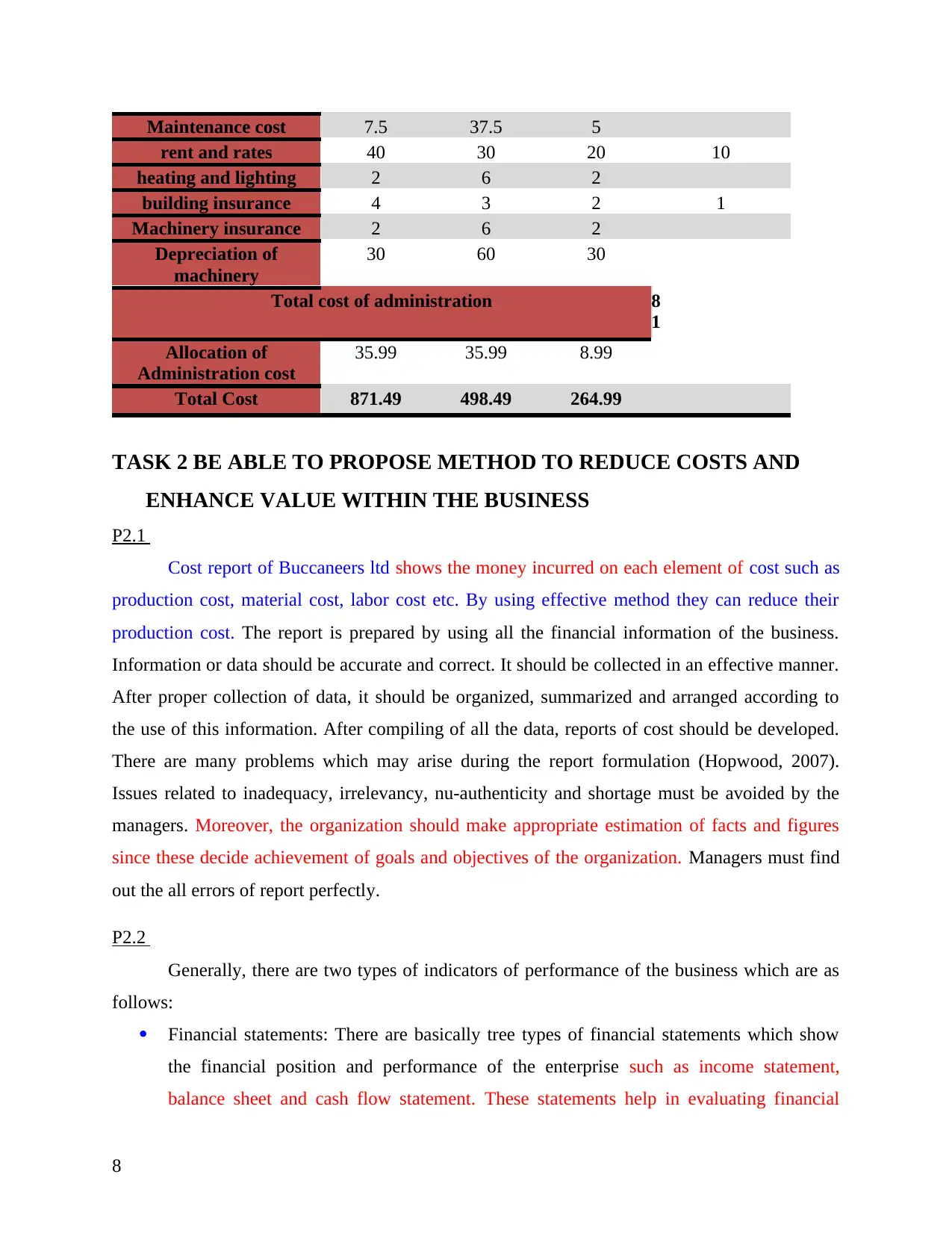
Maintenance cost 7.5 37.5 5
rent and rates 40 30 20 10
heating and lighting 2 6 2
building insurance 4 3 2 1
Machinery insurance 2 6 2
Depreciation of
machinery
30 60 30
Total cost of administration 8
1
Allocation of
Administration cost
35.99 35.99 8.99
Total Cost 871.49 498.49 264.99
TASK 2 BE ABLE TO PROPOSE METHOD TO REDUCE COSTS AND
ENHANCE VALUE WITHIN THE BUSINESS
P2.1
Cost report of Buccaneers ltd shows the money incurred on each element of cost such as
production cost, material cost, labor cost etc. By using effective method they can reduce their
production cost. The report is prepared by using all the financial information of the business.
Information or data should be accurate and correct. It should be collected in an effective manner.
After proper collection of data, it should be organized, summarized and arranged according to
the use of this information. After compiling of all the data, reports of cost should be developed.
There are many problems which may arise during the report formulation (Hopwood, 2007).
Issues related to inadequacy, irrelevancy, nu-authenticity and shortage must be avoided by the
managers. Moreover, the organization should make appropriate estimation of facts and figures
since these decide achievement of goals and objectives of the organization. Managers must find
out the all errors of report perfectly.
P2.2
Generally, there are two types of indicators of performance of the business which are as
follows:
Financial statements: There are basically tree types of financial statements which show
the financial position and performance of the enterprise such as income statement,
balance sheet and cash flow statement. These statements help in evaluating financial
8
rent and rates 40 30 20 10
heating and lighting 2 6 2
building insurance 4 3 2 1
Machinery insurance 2 6 2
Depreciation of
machinery
30 60 30
Total cost of administration 8
1
Allocation of
Administration cost
35.99 35.99 8.99
Total Cost 871.49 498.49 264.99
TASK 2 BE ABLE TO PROPOSE METHOD TO REDUCE COSTS AND
ENHANCE VALUE WITHIN THE BUSINESS
P2.1
Cost report of Buccaneers ltd shows the money incurred on each element of cost such as
production cost, material cost, labor cost etc. By using effective method they can reduce their
production cost. The report is prepared by using all the financial information of the business.
Information or data should be accurate and correct. It should be collected in an effective manner.
After proper collection of data, it should be organized, summarized and arranged according to
the use of this information. After compiling of all the data, reports of cost should be developed.
There are many problems which may arise during the report formulation (Hopwood, 2007).
Issues related to inadequacy, irrelevancy, nu-authenticity and shortage must be avoided by the
managers. Moreover, the organization should make appropriate estimation of facts and figures
since these decide achievement of goals and objectives of the organization. Managers must find
out the all errors of report perfectly.
P2.2
Generally, there are two types of indicators of performance of the business which are as
follows:
Financial statements: There are basically tree types of financial statements which show
the financial position and performance of the enterprise such as income statement,
balance sheet and cash flow statement. These statements help in evaluating financial
8
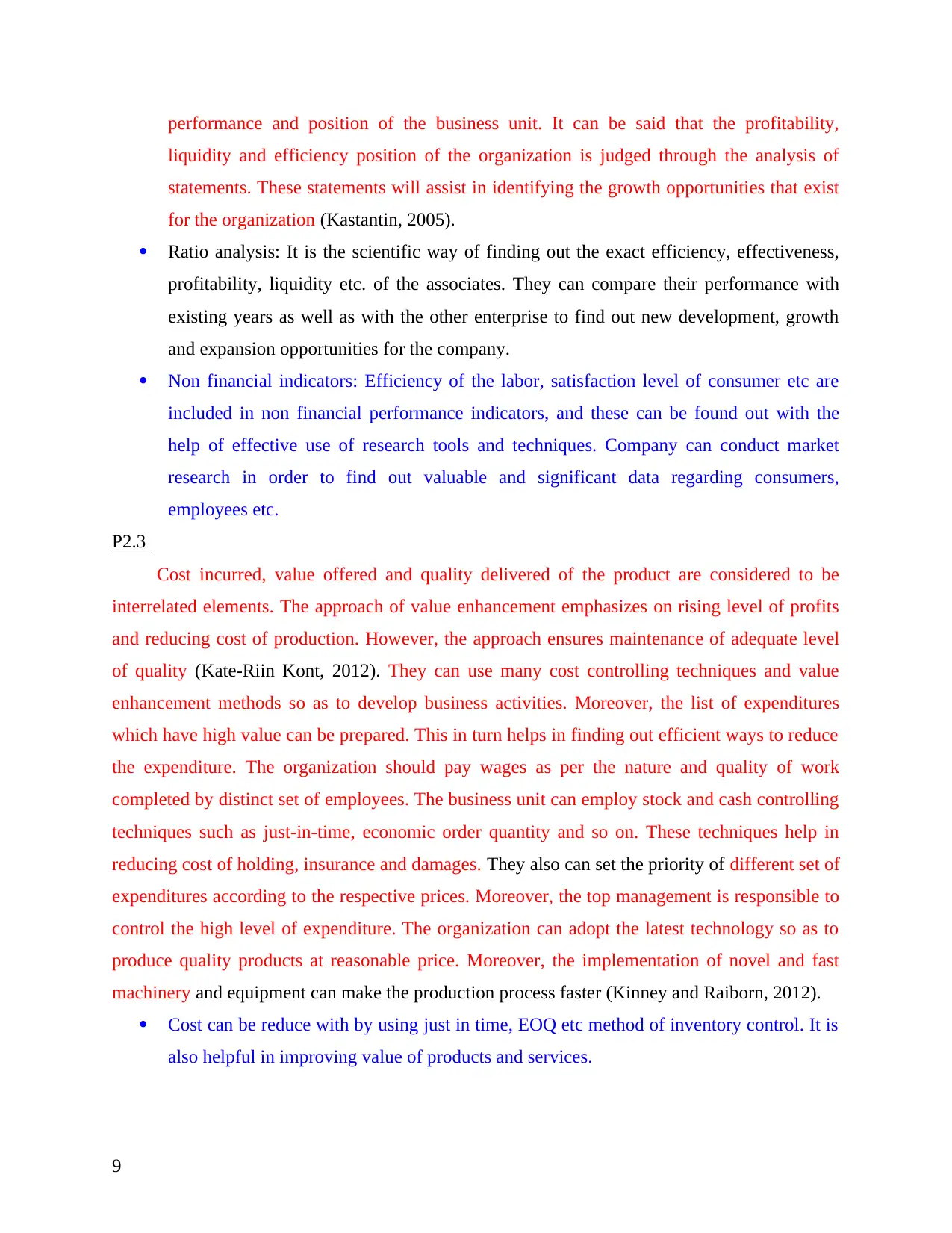
performance and position of the business unit. It can be said that the profitability,
liquidity and efficiency position of the organization is judged through the analysis of
statements. These statements will assist in identifying the growth opportunities that exist
for the organization (Kastantin, 2005).
Ratio analysis: It is the scientific way of finding out the exact efficiency, effectiveness,
profitability, liquidity etc. of the associates. They can compare their performance with
existing years as well as with the other enterprise to find out new development, growth
and expansion opportunities for the company.
Non financial indicators: Efficiency of the labor, satisfaction level of consumer etc are
included in non financial performance indicators, and these can be found out with the
help of effective use of research tools and techniques. Company can conduct market
research in order to find out valuable and significant data regarding consumers,
employees etc.
P2.3
Cost incurred, value offered and quality delivered of the product are considered to be
interrelated elements. The approach of value enhancement emphasizes on rising level of profits
and reducing cost of production. However, the approach ensures maintenance of adequate level
of quality (Kate-Riin Kont, 2012). They can use many cost controlling techniques and value
enhancement methods so as to develop business activities. Moreover, the list of expenditures
which have high value can be prepared. This in turn helps in finding out efficient ways to reduce
the expenditure. The organization should pay wages as per the nature and quality of work
completed by distinct set of employees. The business unit can employ stock and cash controlling
techniques such as just-in-time, economic order quantity and so on. These techniques help in
reducing cost of holding, insurance and damages. They also can set the priority of different set of
expenditures according to the respective prices. Moreover, the top management is responsible to
control the high level of expenditure. The organization can adopt the latest technology so as to
produce quality products at reasonable price. Moreover, the implementation of novel and fast
machinery and equipment can make the production process faster (Kinney and Raiborn, 2012).
Cost can be reduce with by using just in time, EOQ etc method of inventory control. It is
also helpful in improving value of products and services.
9
liquidity and efficiency position of the organization is judged through the analysis of
statements. These statements will assist in identifying the growth opportunities that exist
for the organization (Kastantin, 2005).
Ratio analysis: It is the scientific way of finding out the exact efficiency, effectiveness,
profitability, liquidity etc. of the associates. They can compare their performance with
existing years as well as with the other enterprise to find out new development, growth
and expansion opportunities for the company.
Non financial indicators: Efficiency of the labor, satisfaction level of consumer etc are
included in non financial performance indicators, and these can be found out with the
help of effective use of research tools and techniques. Company can conduct market
research in order to find out valuable and significant data regarding consumers,
employees etc.
P2.3
Cost incurred, value offered and quality delivered of the product are considered to be
interrelated elements. The approach of value enhancement emphasizes on rising level of profits
and reducing cost of production. However, the approach ensures maintenance of adequate level
of quality (Kate-Riin Kont, 2012). They can use many cost controlling techniques and value
enhancement methods so as to develop business activities. Moreover, the list of expenditures
which have high value can be prepared. This in turn helps in finding out efficient ways to reduce
the expenditure. The organization should pay wages as per the nature and quality of work
completed by distinct set of employees. The business unit can employ stock and cash controlling
techniques such as just-in-time, economic order quantity and so on. These techniques help in
reducing cost of holding, insurance and damages. They also can set the priority of different set of
expenditures according to the respective prices. Moreover, the top management is responsible to
control the high level of expenditure. The organization can adopt the latest technology so as to
produce quality products at reasonable price. Moreover, the implementation of novel and fast
machinery and equipment can make the production process faster (Kinney and Raiborn, 2012).
Cost can be reduce with by using just in time, EOQ etc method of inventory control. It is
also helpful in improving value of products and services.
9
⊘ This is a preview!⊘
Do you want full access?
Subscribe today to unlock all pages.

Trusted by 1+ million students worldwide
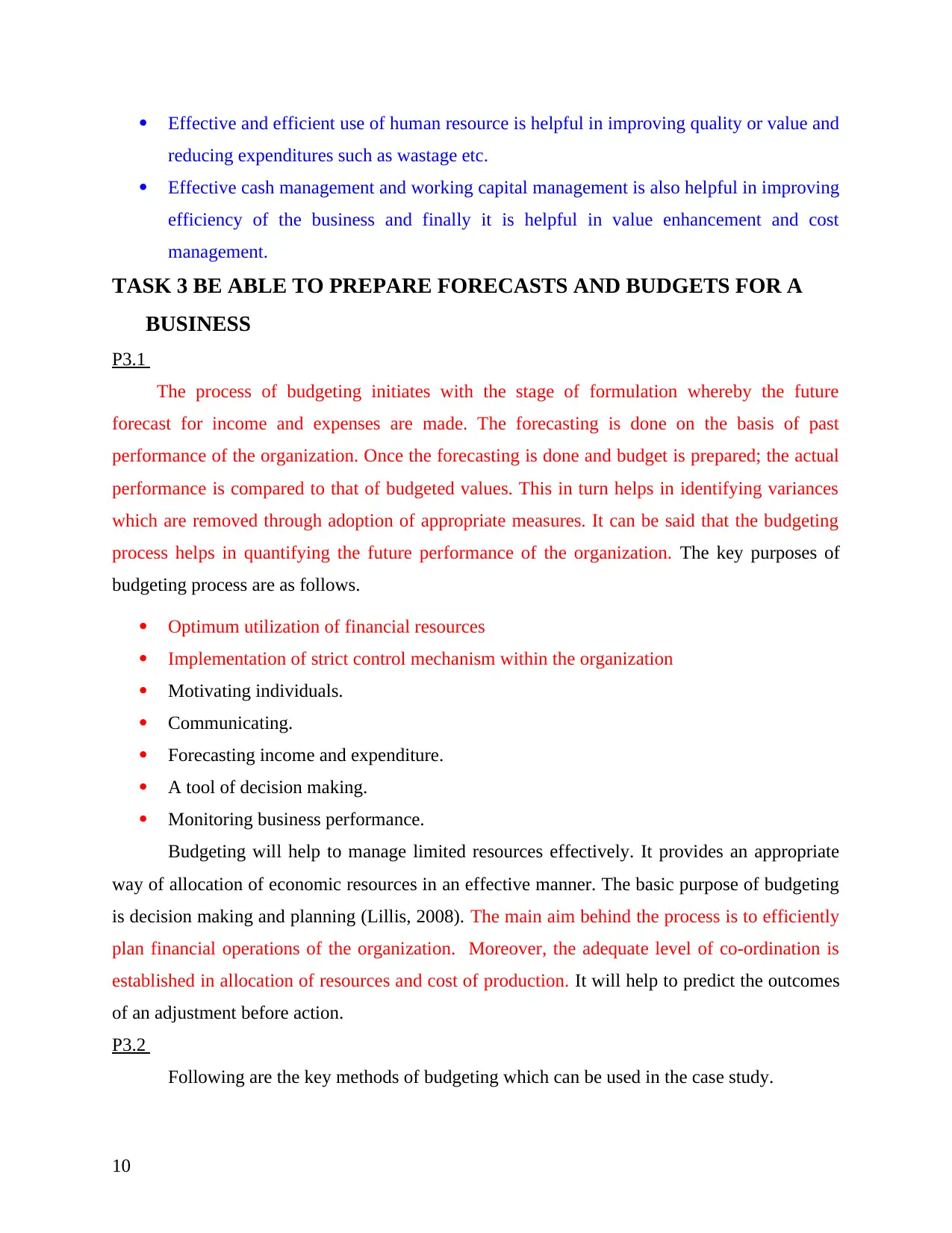
Effective and efficient use of human resource is helpful in improving quality or value and
reducing expenditures such as wastage etc.
Effective cash management and working capital management is also helpful in improving
efficiency of the business and finally it is helpful in value enhancement and cost
management.
TASK 3 BE ABLE TO PREPARE FORECASTS AND BUDGETS FOR A
BUSINESS
P3.1
The process of budgeting initiates with the stage of formulation whereby the future
forecast for income and expenses are made. The forecasting is done on the basis of past
performance of the organization. Once the forecasting is done and budget is prepared; the actual
performance is compared to that of budgeted values. This in turn helps in identifying variances
which are removed through adoption of appropriate measures. It can be said that the budgeting
process helps in quantifying the future performance of the organization. The key purposes of
budgeting process are as follows.
Optimum utilization of financial resources
Implementation of strict control mechanism within the organization
Motivating individuals.
Communicating.
Forecasting income and expenditure.
A tool of decision making.
Monitoring business performance.
Budgeting will help to manage limited resources effectively. It provides an appropriate
way of allocation of economic resources in an effective manner. The basic purpose of budgeting
is decision making and planning (Lillis, 2008). The main aim behind the process is to efficiently
plan financial operations of the organization. Moreover, the adequate level of co-ordination is
established in allocation of resources and cost of production. It will help to predict the outcomes
of an adjustment before action.
P3.2
Following are the key methods of budgeting which can be used in the case study.
10
reducing expenditures such as wastage etc.
Effective cash management and working capital management is also helpful in improving
efficiency of the business and finally it is helpful in value enhancement and cost
management.
TASK 3 BE ABLE TO PREPARE FORECASTS AND BUDGETS FOR A
BUSINESS
P3.1
The process of budgeting initiates with the stage of formulation whereby the future
forecast for income and expenses are made. The forecasting is done on the basis of past
performance of the organization. Once the forecasting is done and budget is prepared; the actual
performance is compared to that of budgeted values. This in turn helps in identifying variances
which are removed through adoption of appropriate measures. It can be said that the budgeting
process helps in quantifying the future performance of the organization. The key purposes of
budgeting process are as follows.
Optimum utilization of financial resources
Implementation of strict control mechanism within the organization
Motivating individuals.
Communicating.
Forecasting income and expenditure.
A tool of decision making.
Monitoring business performance.
Budgeting will help to manage limited resources effectively. It provides an appropriate
way of allocation of economic resources in an effective manner. The basic purpose of budgeting
is decision making and planning (Lillis, 2008). The main aim behind the process is to efficiently
plan financial operations of the organization. Moreover, the adequate level of co-ordination is
established in allocation of resources and cost of production. It will help to predict the outcomes
of an adjustment before action.
P3.2
Following are the key methods of budgeting which can be used in the case study.
10
Paraphrase This Document
Need a fresh take? Get an instant paraphrase of this document with our AI Paraphraser

Incremental budgeting: It is classical and one of very simple methods of budgeting.
Moreover, the budget as per incremental budgeting is prepared by continuously
increasing financial figures of past years at constant or increasing rate. It will be prepared
on consistent basis. The main limitation of this kind of budgets is considered to be its
approach to ignore the impact of changes within organization. Moreover, limited amount
of efforts are involved in development due to lack of innovation. It can be therefore said
that the approach is not considered to be valuable in present dynamic environment
(Obura and Bukenya, 2008).
Zero based budgeting: It overcomes the disadvantage of incremental budgeting. This
approach says that the managers should start their budgeting with zero bases. They
should consider the changes and make a new budget every year by starting with zero
level. It is the modern method through which they can allocate resources efficiently. This
type of budgeting may be used by the big companies because it requires trained and
expert employees.
Top down budgeting: It provides importance on the priority of work done. It says that
they should estimate the expenditure of raised level tasks introductory and use this
approximation to constrain the calculation for subordinate level. This way takes very
fewer time frames than others and appraises upper level loyalty (Standard Costs and
Variance Analysis. 2007). This is the method utilized by the company in the present case.
Hence, it can be said that it is the best way of controlling and managing variance as it
includes less involvement of low level workers of the entity.
Bottom up budgeting: In this technique, budgets are formed by incorporating the input of
subordinate level administration. The counsel and procedure are developed by strategic
level but budgets are prepared by the individual departments. It is also a good method
which can provide full information of activities easily. The company can use this kind of
budgets with experienced employees.
P3.3
Antonio Ltd. can set up their budget with the help of the following procedure.
Preparation of budget: The process outset with the preparation stage where they estimate
the income and expenses within the company (Thomas, 2009). It is the first step of the
budgeting.
11
Moreover, the budget as per incremental budgeting is prepared by continuously
increasing financial figures of past years at constant or increasing rate. It will be prepared
on consistent basis. The main limitation of this kind of budgets is considered to be its
approach to ignore the impact of changes within organization. Moreover, limited amount
of efforts are involved in development due to lack of innovation. It can be therefore said
that the approach is not considered to be valuable in present dynamic environment
(Obura and Bukenya, 2008).
Zero based budgeting: It overcomes the disadvantage of incremental budgeting. This
approach says that the managers should start their budgeting with zero bases. They
should consider the changes and make a new budget every year by starting with zero
level. It is the modern method through which they can allocate resources efficiently. This
type of budgeting may be used by the big companies because it requires trained and
expert employees.
Top down budgeting: It provides importance on the priority of work done. It says that
they should estimate the expenditure of raised level tasks introductory and use this
approximation to constrain the calculation for subordinate level. This way takes very
fewer time frames than others and appraises upper level loyalty (Standard Costs and
Variance Analysis. 2007). This is the method utilized by the company in the present case.
Hence, it can be said that it is the best way of controlling and managing variance as it
includes less involvement of low level workers of the entity.
Bottom up budgeting: In this technique, budgets are formed by incorporating the input of
subordinate level administration. The counsel and procedure are developed by strategic
level but budgets are prepared by the individual departments. It is also a good method
which can provide full information of activities easily. The company can use this kind of
budgets with experienced employees.
P3.3
Antonio Ltd. can set up their budget with the help of the following procedure.
Preparation of budget: The process outset with the preparation stage where they estimate
the income and expenses within the company (Thomas, 2009). It is the first step of the
budgeting.
11
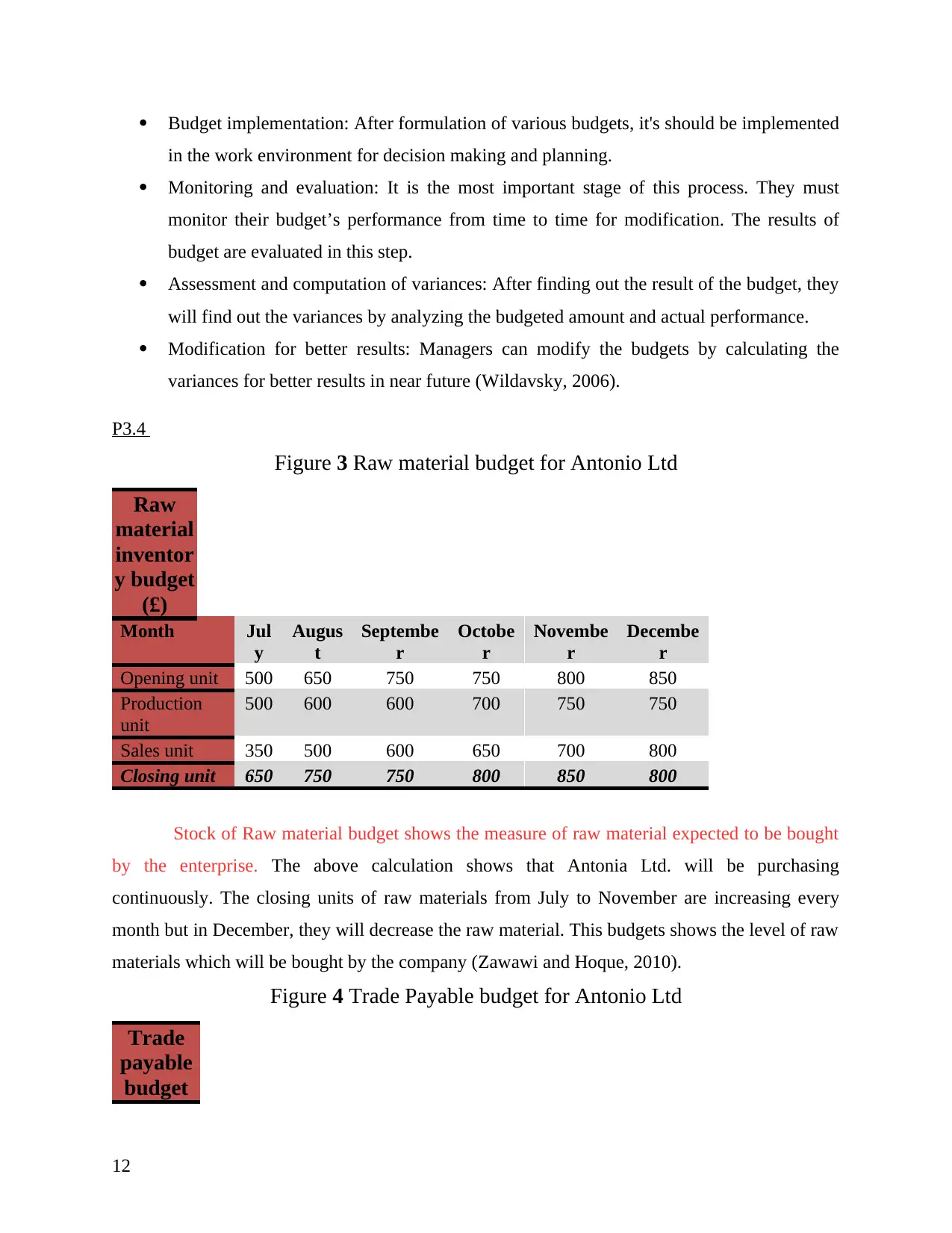
Budget implementation: After formulation of various budgets, it's should be implemented
in the work environment for decision making and planning.
Monitoring and evaluation: It is the most important stage of this process. They must
monitor their budget’s performance from time to time for modification. The results of
budget are evaluated in this step.
Assessment and computation of variances: After finding out the result of the budget, they
will find out the variances by analyzing the budgeted amount and actual performance.
Modification for better results: Managers can modify the budgets by calculating the
variances for better results in near future (Wildavsky, 2006).
P3.4
Figure 3 Raw material budget for Antonio Ltd
Raw
material
inventor
y budget
(£)
Month Jul
y
Augus
t
Septembe
r
Octobe
r
Novembe
r
Decembe
r
Opening unit 500 650 750 750 800 850
Production
unit
500 600 600 700 750 750
Sales unit 350 500 600 650 700 800
Closing unit 650 750 750 800 850 800
Stock of Raw material budget shows the measure of raw material expected to be bought
by the enterprise. The above calculation shows that Antonia Ltd. will be purchasing
continuously. The closing units of raw materials from July to November are increasing every
month but in December, they will decrease the raw material. This budgets shows the level of raw
materials which will be bought by the company (Zawawi and Hoque, 2010).
Figure 4 Trade Payable budget for Antonio Ltd
Trade
payable
budget
12
in the work environment for decision making and planning.
Monitoring and evaluation: It is the most important stage of this process. They must
monitor their budget’s performance from time to time for modification. The results of
budget are evaluated in this step.
Assessment and computation of variances: After finding out the result of the budget, they
will find out the variances by analyzing the budgeted amount and actual performance.
Modification for better results: Managers can modify the budgets by calculating the
variances for better results in near future (Wildavsky, 2006).
P3.4
Figure 3 Raw material budget for Antonio Ltd
Raw
material
inventor
y budget
(£)
Month Jul
y
Augus
t
Septembe
r
Octobe
r
Novembe
r
Decembe
r
Opening unit 500 650 750 750 800 850
Production
unit
500 600 600 700 750 750
Sales unit 350 500 600 650 700 800
Closing unit 650 750 750 800 850 800
Stock of Raw material budget shows the measure of raw material expected to be bought
by the enterprise. The above calculation shows that Antonia Ltd. will be purchasing
continuously. The closing units of raw materials from July to November are increasing every
month but in December, they will decrease the raw material. This budgets shows the level of raw
materials which will be bought by the company (Zawawi and Hoque, 2010).
Figure 4 Trade Payable budget for Antonio Ltd
Trade
payable
budget
12
⊘ This is a preview!⊘
Do you want full access?
Subscribe today to unlock all pages.

Trusted by 1+ million students worldwide
1 out of 18
Related Documents
Your All-in-One AI-Powered Toolkit for Academic Success.
+13062052269
info@desklib.com
Available 24*7 on WhatsApp / Email
![[object Object]](/_next/static/media/star-bottom.7253800d.svg)
Unlock your academic potential
Copyright © 2020–2025 A2Z Services. All Rights Reserved. Developed and managed by ZUCOL.





